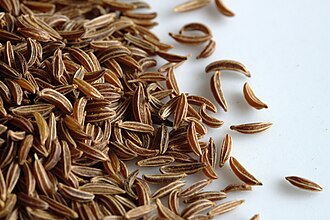Caraway

Caraway (Carum carvi), also known as meridian fennel or Persian cumin, is a biennial plant in the family Apiaceae, native to western Asia, Europe, and North Africa. The plant is similar in appearance to other members of the carrot family, with finely divided, feathery leaves with thread-like divisions, growing on 20–30 cm stems. The main flower stem is 40–60 cm tall, with small white or pink flowers in umbels. Caraway fruits, commonly referred to as seeds, are crescent-shaped achenes, around 2 mm long, with five pale ridges.
Uses[edit]
Caraway seeds are used as a spice in breads, especially rye bread. Caraway is also used in desserts, liquors, casseroles, and other foods. Its leaves can be eaten as herbs, either raw, dried, or cooked, similar to parsley. Additionally, caraway seed oil is used in the flavoring of certain foods and in traditional medicines.
Cultivation[edit]
Caraway is grown widely, with Finland, Poland, the Netherlands, and Germany being major commercial producers. It prefers a well-drained, fertile soil and a sunny position. Being a biennial, caraway won't mature and produce seeds until its second year, although some varieties can complete their lifecycle in a single year, these are known as annual varieties.
Culinary Uses[edit]
In culinary applications, caraway has a distinctive sweet but tangy flavor, which complements a wide variety of foods. It is a key ingredient in sauerkraut, coleslaw, and goulash, and is used in seasoning cheese, particularly Gouda and Munster. Caraway seeds are also used in liquors such as aquavit and schnapps.
Medicinal Uses[edit]
Traditionally, caraway has been used in herbal medicine to treat digestive problems, including heartburn, bloating, gas, and mild spasms of the stomach and intestines. Caraway oil is sometimes added to cosmetics for fragrance and is believed to have antimicrobial properties.
In Culture[edit]
Caraway has a long history of use in folk magic and was believed to ward off witches and evil spirits. It was also thought to bring about loyalty and was used in love potions.
Ad. Transform your life with W8MD's Budget GLP-1 injections from $75


W8MD offers a medical weight loss program to lose weight in Philadelphia. Our physician-supervised medical weight loss provides:
- Weight loss injections in NYC (generic and brand names):
- Zepbound / Mounjaro, Wegovy / Ozempic, Saxenda
- Most insurances accepted or discounted self-pay rates. We will obtain insurance prior authorizations if needed.
- Generic GLP1 weight loss injections from $75 for the starting dose.
- Also offer prescription weight loss medications including Phentermine, Qsymia, Diethylpropion, Contrave etc.
NYC weight loss doctor appointmentsNYC weight loss doctor appointments
Start your NYC weight loss journey today at our NYC medical weight loss and Philadelphia medical weight loss clinics.
- Call 718-946-5500 to lose weight in NYC or for medical weight loss in Philadelphia 215-676-2334.
- Tags:NYC medical weight loss, Philadelphia lose weight Zepbound NYC, Budget GLP1 weight loss injections, Wegovy Philadelphia, Wegovy NYC, Philadelphia medical weight loss, Brookly weight loss and Wegovy NYC
|
WikiMD's Wellness Encyclopedia |
| Let Food Be Thy Medicine Medicine Thy Food - Hippocrates |
Medical Disclaimer: WikiMD is not a substitute for professional medical advice. The information on WikiMD is provided as an information resource only, may be incorrect, outdated or misleading, and is not to be used or relied on for any diagnostic or treatment purposes. Please consult your health care provider before making any healthcare decisions or for guidance about a specific medical condition. WikiMD expressly disclaims responsibility, and shall have no liability, for any damages, loss, injury, or liability whatsoever suffered as a result of your reliance on the information contained in this site. By visiting this site you agree to the foregoing terms and conditions, which may from time to time be changed or supplemented by WikiMD. If you do not agree to the foregoing terms and conditions, you should not enter or use this site. See full disclaimer.
Credits:Most images are courtesy of Wikimedia commons, and templates, categories Wikipedia, licensed under CC BY SA or similar.
Translate this page: - East Asian
中文,
日本,
한국어,
South Asian
हिन्दी,
தமிழ்,
తెలుగు,
Urdu,
ಕನ್ನಡ,
Southeast Asian
Indonesian,
Vietnamese,
Thai,
မြန်မာဘာသာ,
বাংলা
European
español,
Deutsch,
français,
Greek,
português do Brasil,
polski,
română,
русский,
Nederlands,
norsk,
svenska,
suomi,
Italian
Middle Eastern & African
عربى,
Turkish,
Persian,
Hebrew,
Afrikaans,
isiZulu,
Kiswahili,
Other
Bulgarian,
Hungarian,
Czech,
Swedish,
മലയാളം,
मराठी,
ਪੰਜਾਬੀ,
ગુજરાતી,
Portuguese,
Ukrainian
